

Compact Muon Solenoid
LHC, CERN
| CMS-PAS-SUS-16-037 | ||
| Search for supersymmetry in pp collisions at $\sqrt s = $ 13 TeV in the single-lepton final state using the sum of masses of large-radius jets | ||
| CMS Collaboration | ||
| March 2017 | ||
| Abstract: Results are reported from a search for supersymmetric particles in proton-proton collisions in the final state with a single high transverse momentum lepton; multiple jets, including at least one b-tagged jet; and large missing transverse momentum. The search uses a 35.9 fb$^{-1}$ sample of proton-proton collision data at $\sqrt{s} =$ 13 TeV accumulated by the CMS experiment at the LHC. The observed event yields in the signal regions are consistent with those expected for standard model backgrounds. The results are interpreted in the context of simplified models of supersymmetry involving gluino pair production, with gluino decay into either on- or off-mass-shell top squarks. Assuming that the top squarks decay into a top quark plus a stable, weakly interacting neutralino, scenarios with gluino masses up to about 1.9 TeV are excluded at a 95% CL for neutralino masses up to about 1 TeV. | ||
|
Links:
CDS record (PDF) ;
inSPIRE record ;
CADI line (restricted) ;
These preliminary results are superseded in this paper, PRL 119 (2017) 151802. The superseded preliminary plots can be found here. |
||
| Figures & Tables | Summary | Additional Figures & Tables | References | CMS Publications |
|---|
| Additional information on efficiencies needed for reinterpretation of these results are available here. Additional technical material for CMS speakers can be found here |
| Figures | |

png pdf |
Figure 1:
Distributions of ${M_J}$ observed in data for 200 $ < { {p_{\mathrm {T}}} ^\text {miss}} \leq $ 350 GeV (left) and $ { {p_{\mathrm {T}}} ^\text {miss}} > $ 350 GeV (right) in the 1$\ell $ data for low ($\leq $ 140 GeV) ${m_{\mathrm {T}}}$ and high ($>$ 140 GeV) $ {m_{\mathrm {T}}}$ regions. In each plot, the data at low $ {m_{\mathrm {T}}} $ have been renormalized to the yield observed at high $ {m_{\mathrm {T}}} $ to facilitate the comparison of the shapes of the distributions. The vertical dashed line at $ {M_J} = $ 250 GeV shows the lower boundary of regions R1 and R3, while the vertical line at $ {M_J} = $ 400 GeV separates R1 and R3 from R2 and R4. The data are integrated over $ {N_{\text {jets}}} \geq $ 6 and $ {N_{\text {b}}} \geq $ 2. Two SUSY benchmark models are shown in the solid and dashed red histograms. |
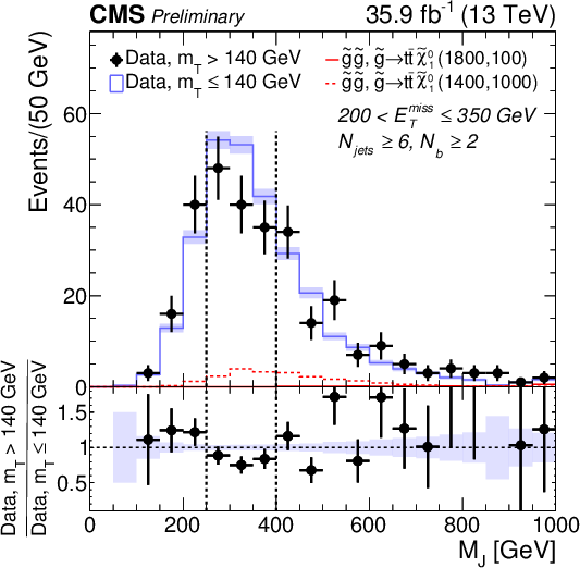
png pdf |
Figure 1-a:
Distribution of ${M_J}$ observed in data for 200 $ < { {p_{\mathrm {T}}} ^\text {miss}} \leq $ 350 GeV in the 1$\ell $ data for low ($\leq $ 140 GeV) ${m_{\mathrm {T}}}$ and high ($>$ 140 GeV) $ {m_{\mathrm {T}}}$ regions. The data at low $ {m_{\mathrm {T}}} $ have been renormalized to the yield observed at high $ {m_{\mathrm {T}}} $ to facilitate the comparison of the shapes of the distributions. The vertical dashed line at $ {M_J} = $ 250 GeV shows the lower boundary of regions R1 and R3, while the vertical line at $ {M_J} = $ 400 GeV separates R1 and R3 from R2 and R4. The data are integrated over $ {N_{\text {jets}}} \geq $ 6 and $ {N_{\text {b}}} \geq $ 2. Two SUSY benchmark models are shown in the solid and dashed red histograms. |
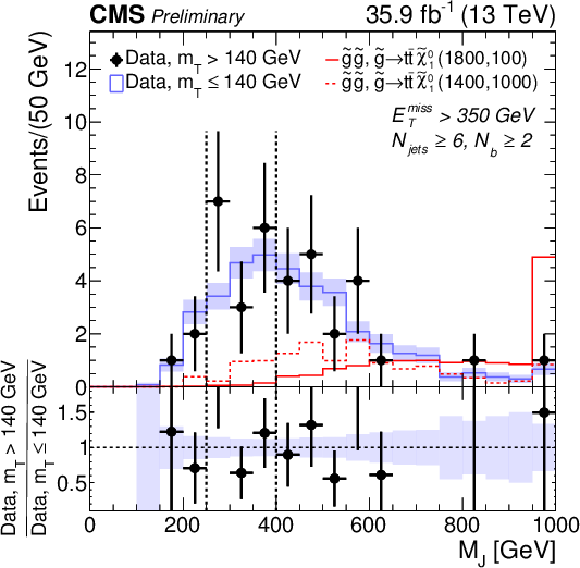
png pdf |
Figure 1-b:
Distribution of ${M_J}$ observed in data for $ { {p_{\mathrm {T}}} ^\text {miss}} > $ 350 GeV in the 1$\ell $ data for low ($\leq $ 140 GeV) ${m_{\mathrm {T}}}$ and high ($>$ 140 GeV) $ {m_{\mathrm {T}}}$ regions. The data at low $ {m_{\mathrm {T}}} $ have been renormalized to the yield observed at high $ {m_{\mathrm {T}}} $ to facilitate the comparison of the shapes of the distributions. The vertical dashed line at $ {M_J} = $ 250 GeV shows the lower boundary of regions R1 and R3, while the vertical line at $ {M_J} = $ 400 GeV separates R1 and R3 from R2 and R4. The data are integrated over $ {N_{\text {jets}}} \geq $ 6 and $ {N_{\text {b}}} \geq $ 2. Two SUSY benchmark models are shown in the solid and dashed red histograms. |
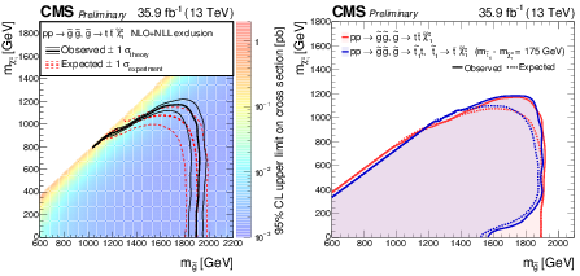
png pdf |
Figure 2:
Left: excluded cross sections and SUSY particle masses for the T1tttt model. The color map indicates cross section time branching fraction upper limits at a 95% confidence level across the T1tttt mass plane. The black (red) line shows the observed (expected) exclusion of mass scenarios with theoretical cross sections higher than their respective upper limits. Limits are computed using the global fit. Right: comparison of the excluded gluino and LSP masses for the T1tttt and T5tttt models. The gluino mass limits are similar except at low $m_{ \tilde{\chi }^0_1} $. |

png pdf root |
Figure 2-a:
Excluded cross sections and SUSY particle masses for the T1tttt model. The color map indicates cross section time branching fraction upper limits at a 95% confidence level across the T1tttt mass plane. The black (red) line shows the observed (expected) exclusion of mass scenarios with theoretical cross sections higher than their respective upper limits. Limits are computed using the global fit. |
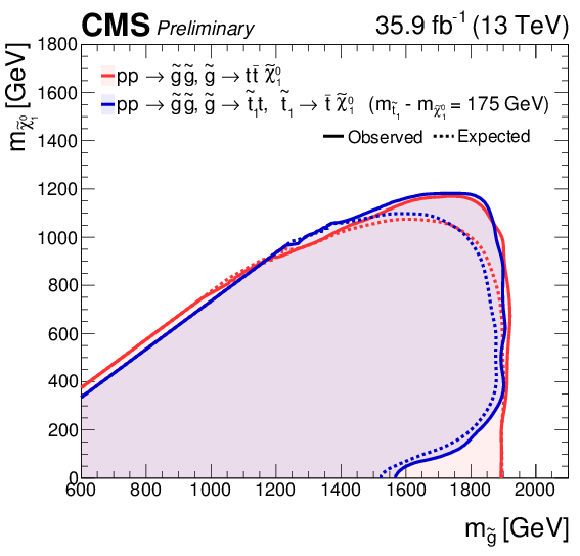
png pdf root |
Figure 2-b:
Comparison of the excluded gluino and LSP masses for the T1tttt and T5tttt models. The gluino mass limits are similar except at low $m_{ \tilde{\chi }^0_1} $. |
| Tables | |
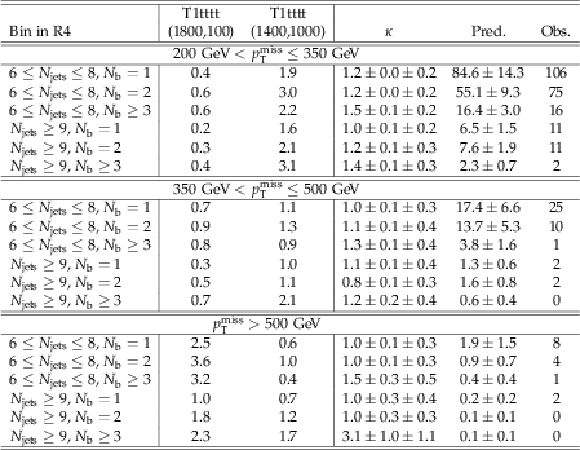
png pdf |
Table 1:
Observed event yields and mean background yields from the predictive fit in the 18 bins of the signal region R4. The uncertainties in $\kappa $ include (in order) both a statistical component from the size of the MC samples and a systematic component assessed from data control samples. The uncertainty in the predicted event yield includes both these and the statistical uncertainties associated with the control regions in the data. Also shown are the expected signal yields for two SUSY benchmark models. |

png pdf |
Table 2:
Observed event yields and mean background yields from a predictive fit in four aggregate search bins. In all four cases, the predicted yields refer to R4 with the usual requirements of $ {m_{\mathrm {T}}} > $ 140 GeV and $ {M_J} > $ 400 GeV applied in addition to the baseline selection. Unlike the finely binned approach, where all 18 background predictions are found simultaneously, the four aggregate bin predictions here are computed separately and may be highly correlated due to overlapping definitions. |
| Summary |
| In summary, we have performed a search for an excess event yield above that expected for SM processes using a data sample of proton-proton collision events with an integrated luminosity of 35.9 fb$^{-1}$ at $\sqrt{s} =$ 13 TeV. The signature is based on events with large missing transverse momentum, a single isolated lepton, multiple high pT jets, and at least one b-tagged jet. No significant excesses above the expected SM backgrounds is observed in any of the signal regions. The results are interpreted in the framework of simplified models that describe important natural SUSY scenarios with gluino pair production, followed by gluino decay into top quarks and a neutralino. For three-body decay, gluinos with masses below 1.9 TeV are excluded at a 95% CL for neutralino masses up to about 1 TeV. The results for two-body gluino decay are generally similar except at low neutralino masses, where the exclusion weakens. These results are among the most stringent constraints on these SUSY models to date. |
| Additional Figures | |
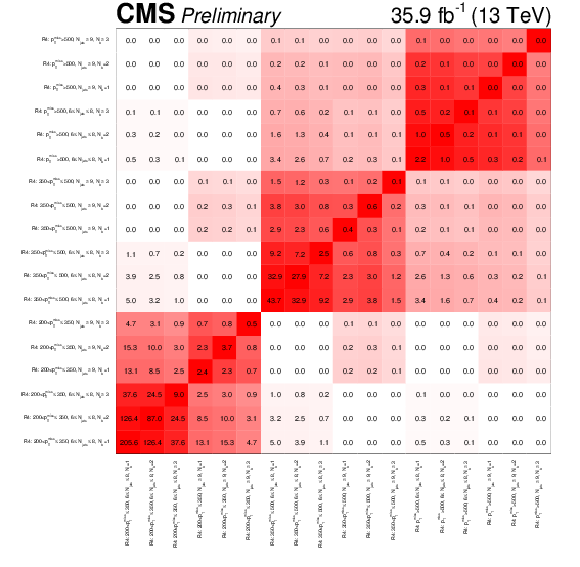
png pdf root |
Additional Figure 1:
Covariance matrix for the expected backgrounds from the predictive fit. |
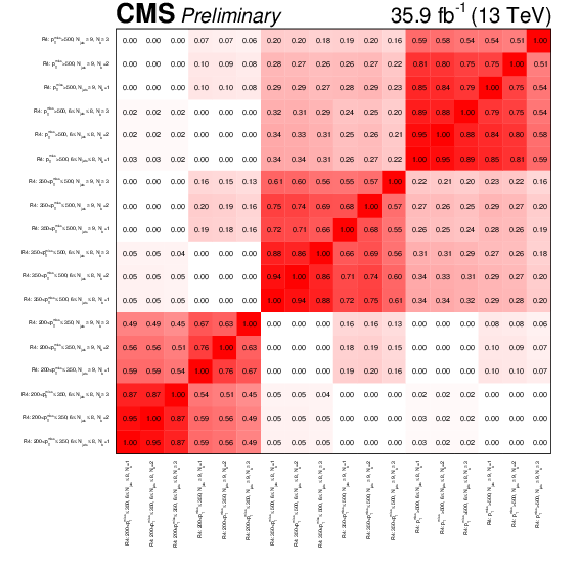
png pdf root |
Additional Figure 2:
Correlation matrix for expected backgrounds from the predictive fit. |

png pdf |
Additional Figure 3:
Observed significance in the T1tttt plane. |
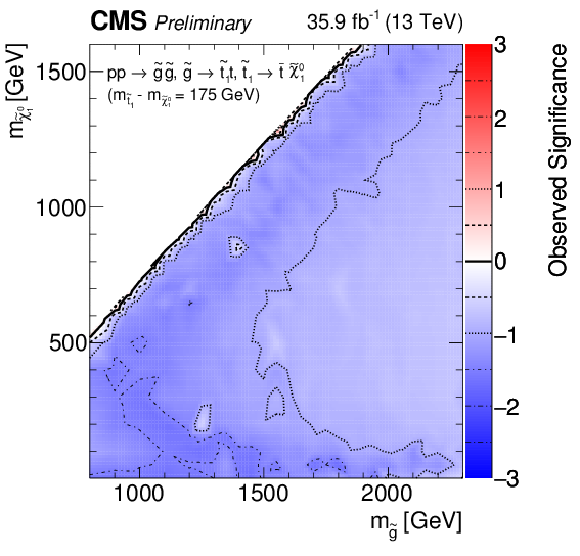
png pdf |
Additional Figure 4:
Observed significance in the T5tttt plane. |
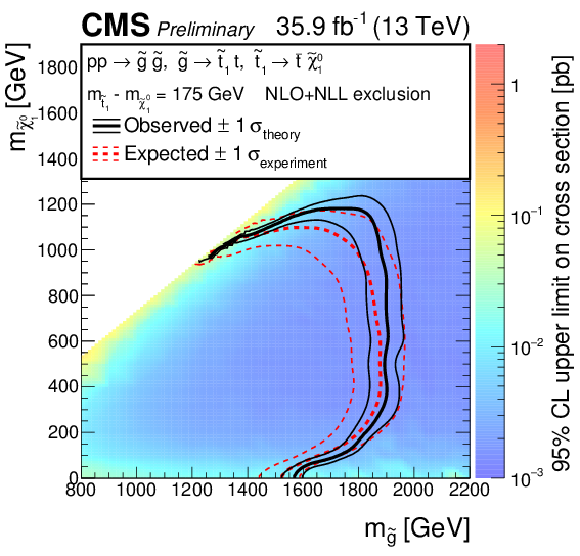
png pdf root |
Additional Figure 5:
Exclusion limits at 95% confidence level in the T5tttt plane. |
| Additional Tables | |

png pdf |
Additional Table 1:
Cutflow table. Rows above the single horizontal line are part of the "baseline selection.'' For the T1tttt and T5tttt signal models, (1800,100) denotes $m_{\text {gluino}}= $ 1800 GeV, $m_{\text {LSP}}= $ 100 GeV, while (1400,1000) denotes $m_{\text {gluino}}= $ 1400 GeV, $m_{\text {LSP}}= $ 1000 GeV. |
| References | ||||
| 1 | P. Ramond | Dual theory for free fermions | PRD 3 (1971) 2415 | |
| 2 | Y. A. Golfand and E. P. Likhtman | Extension of the algebra of Poincare group generators and violation of P invariance | JEPTL 13 (1971)323 | |
| 3 | A. Neveu and J. H. Schwarz | Factorizable dual model of pions | Nucl. Phys. B 31 (1971) 86 | |
| 4 | D. V. Volkov and V. P. Akulov | Possible universal neutrino interaction | JEPTL 16 (1972)438 | |
| 5 | J. Wess and B. Zumino | A Lagrangian model invariant under supergauge transformations | PLB 49 (1974) 52 | |
| 6 | J. Wess and B. Zumino | Supergauge transformations in four dimensions | Nucl. Phys. B 70 (1974) 39 | |
| 7 | P. Fayet | Supergauge invariant extension of the Higgs mechanism and a model for the electron and its neutrino | Nucl. Phys. B 90 (1975) 104 | |
| 8 | H. P. Nilles | Supersymmetry, supergravity and particle physics | Phys. Rep. 110 (1984) 1 | |
| 9 | ATLAS Collaboration | Search for squarks and gluinos in events with isolated leptons, jets and missing transverse momentum at $ \sqrt{s}= $ 8 TeV with the ATLAS detector | JHEP 04 (2015) 116 | 1501.03555 |
| 10 | CMS Collaboration | Search for supersymmetry in pp collisions at $ \sqrt{s} = $ 8 TeV in events with a single lepton, large jet multiplicity, and multiple b jets | PLB 733 (2014) 328 | CMS-SUS-13-007 1311.4937 |
| 11 | ATLAS Collaboration | Search for gluinos in events with an isolated lepton, jets and missing transverse momentum at $ \sqrt{s}= $ 13 TeV with the ATLAS detector | EPJC 76 (2016), no. 10, 565 | 1605.04285 |
| 12 | CMS Collaboration | Search for supersymmetry in pp collisions at $ \sqrt{s}=13 $ TeV in the single-lepton final state using the sum of masses of large-radius jets | JHEP 08 (2016) 122 | CMS-SUS-15-007 1605.04608 |
| 13 | CMS Collaboration | Search for supersymmetry in events with one lepton and multiple jets in proton-proton collisions at $ \sqrt{s} = $ 13 TeV | PRD 95 (2017) 012011 | CMS-SUS-15-006 1609.09386 |
| 14 | ATLAS Collaboration | Observation of a new particle in the search for the Standard Model Higgs boson with the ATLAS detector at the LHC | PLB 716 (2012) 1 | 1207.7214 |
| 15 | CMS Collaboration | Observation of a new boson at a mass of 125 GeV with the CMS experiment at the LHC | PLB 716 (2012) 30 | CMS-HIG-12-028 1207.7235 |
| 16 | CMS Collaboration | Observation of a new boson with mass near 125 GeV in pp collisions at $ \sqrt{s} = $ 7 and 8 TeV | JHEP 06 (2013) 081 | CMS-HIG-12-036 1303.4571 |
| 17 | CMS Collaboration | Precise determination of the mass of the Higgs boson and tests of compatibility of its couplings with the standard model predictions using proton collisions at 7 and 8 TeV | EPJC 75 (2015) 212 | CMS-HIG-14-009 1412.8662 |
| 18 | ATLAS Collaboration | Measurement of the Higgs boson mass from the $ \textrm{H}\rightarrow \gamma\gamma $ and $ \textrm{H} \rightarrow \textrm{ZZ}^{*} \rightarrow 4\ell $ channels with the ATLAS detector using 25 fb$ ^{-1} $ of $ \textrm{pp} $ collision data | PRD 90 (2014) 052004 | 1406.3827 |
| 19 | ATLAS and CMS Collaborations | Combined Measurement of the Higgs Boson Mass in pp Collisions at $ \sqrt{s}= $ 7 and 8 TeV with the ATLAS and CMS Experiments | PRL 114 (2015) 191803 | 1503.07589 |
| 20 | G. 't Hooft | Naturalness, chiral symmetry, and spontaneous chiral symmetry breaking | NATO Sci. Ser. B 59 (1980)135 | |
| 21 | E. Witten | Dynamical Breaking of Supersymmetry | Nucl. Phys. B 188 (1981) 513 | |
| 22 | M. Dine, W. Fischler, and M. Srednicki | Supersymmetric Technicolor | Nucl. Phys. B 189 (1981) 575 | |
| 23 | S. Dimopoulos and S. Raby | Supercolor | Nucl. Phys. B 192 (1981) 353 | |
| 24 | S. Dimopoulos and H. Georgi | Softly Broken Supersymmetry and SU(5) | Nucl. Phys. B 193 (1981) 150 | |
| 25 | R. K. Kaul and P. Majumdar | Cancellation of Quadratically Divergent Mass Corrections in Globally Supersymmetric Spontaneously Broken Gauge Theories | Nucl. Phys. B 199 (1982) 36 | |
| 26 | S. Dimopoulos and G. F. Giudice | Naturalness constraints in supersymmetric theories with nonuniversal soft terms | PLB 357 (1995) 573 | hep-ph/9507282 |
| 27 | R. Barbieri and D. Pappadopulo | S-particles at their naturalness limits | JHEP 10 (2009) 061 | 0906.4546 |
| 28 | M. Papucci, J. T. Ruderman, and A. Weiler | Natural SUSY endures | JHEP 09 (2012) 035 | 1110.6926 |
| 29 | J. L. Feng | Naturalness and the Status of Supersymmetry | Ann. Rev. Nucl. Part. Sci. 63 (2013) 351 | 1302.6587 |
| 30 | G. R. Farrar and P. Fayet | Phenomenology of the Production, Decay, and Detection of New Hadronic States Associated with Supersymmetry | PLB 76 (1978) 575 | |
| 31 | S. P. Martin | A supersymmetry primer | Adv. Ser. Direct. High Energy Phys. 18 (1998) 1 | hep-ph/9709356 |
| 32 | CMS Collaboration | Interpretation of Searches for Supersymmetry with simplified Models | PRD 88 (2013) 052017 | CMS-SUS-11-016 1301.2175 |
| 33 | J. Alwall, P. Schuster, and N. Toro | Simplified models for a first characterization of new physics at the LHC | PRD 79 (2009) 075020 | 0810.3921 |
| 34 | J. Alwall, M.-P. Le, M. Lisanti, and J. G. Wacker | Model-independent jets plus missing energy searches | PRD 79 (2009) 015005 | 0809.3264 |
| 35 | D. Alves et al. | Simplified models for LHC new physics searches | JPG 39 (2012) 105005 | 1105.2838 |
| 36 | CMS Collaboration | The CMS experiment at the CERN LHC | JINST 3 (2008) S08004 | CMS-00-001 |
| 37 | J. Alwall et al. | The automated computation of tree-level and next-to-leading order differential cross sections, and their matching to parton shower simulations | JHEP 07 (2014) 079 | 1405.0301 |
| 38 | GEANT4 Collaboration | GEANT4 --- a simulation toolkit | NIMA 506 (2003) 250 | |
| 39 | CMS Collaboration | The fast simulation of the CMS detector at LHC | J. Phys. Conf. Ser. 331 (2011) 032049 | |
| 40 | CMS Collaboration | Particle flow event reconstruction in CMS and performance for jets, taus and~$ E_{\mathrm{T}}^{\text{miss}} $ | CDS | |
| 41 | CMS Collaboration | Commissioning of the particle-flow event reconstruction with the first LHC collisions recorded in the CMS detector | CDS | |
| 42 | CMS Collaboration | Performance of electron reconstruction and selection with the CMS detector in proton-proton collisions at $ \sqrt{s} = $ 8 TeV | JINST 10 (2015) P06005 | CMS-EGM-13-001 1502.02701 |
| 43 | CMS Collaboration | Performance of CMS muon reconstruction in pp collision events at $ \sqrt{s}= $ 7 TeV | JINST 7 (2012) P10002 | CMS-MUO-10-004 1206.4071 |
| 44 | K. Rehermann and B. Tweedie | Efficient Identification of Boosted Semileptonic Top Quarks at the LHC | JHEP 03 (2011) 059 | 1007.2221 |
| 45 | C. Lester and D. Summers | Measuring masses of semi-invisibly decaying particle pairs produced at hadron colliders | PLB 463 (1999) 5 | |
| 46 | M. Cacciari, G. P. Salam, and G. Soyez | The anti-$ k_{\rm t} $ jet clustering algorithm | JHEP 04 (2008) 063 | 0802.1189 |
| 47 | M. Cacciari, G. P. Salam, and G. Soyez | FastJet User Manual | EPJC72 (2012) 1896 | 1111.6097 |
| 48 | CMS Collaboration | Identification of b-quark jets with the CMS experiment | JINST 8 (2013) P04013 | CMS-BTV-12-001 1211.4462 |
| 49 | CMS Collaboration | Identification of b quark jets at the CMS Experiment in the LHC Run 2 | CMS-PAS-BTV-15-001 | CMS-PAS-BTV-15-001 |

|
Compact Muon Solenoid LHC, CERN |

|

|

|

|

|

|